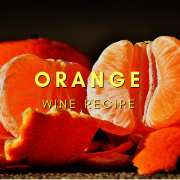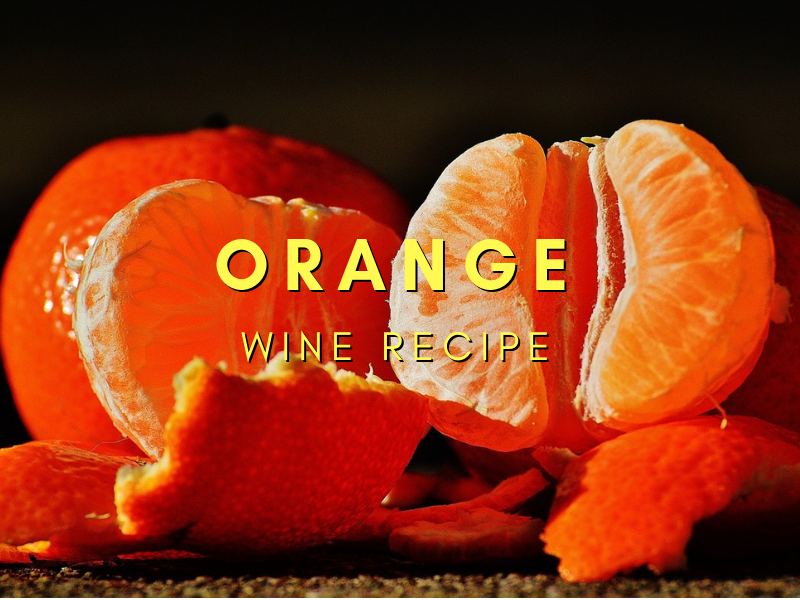Zesty Orange Wine Recipe
Orange wine is unique. Maybe not as popular as some of the other fruit wines but can make a great early evening sipper with a little thought going into the recipe. This recipe is good for any type of orange, tangerine, mandarin or blood orange so it is worth experimenting to find your perfect flavour.
Table of Contents
Light & Zesty Orange Wine
If anyone has ever tried fermenting orange juice then you will know that the outcome is usually not so good. Orange juice, of course, is just one part of the fruit. There is the juice, the pulp and the zest. Nearly all of that orange flavour we want to retain in this wine recipe comes from the zest.
The juice is delicately flavoured and light tasting, fermenting this alone drives off the “orangeness” we want to remain in the finished wine. The zest, on the other hand, is packed full of oils that are truly the essence of orange. Utilising the zest in this orange wine recipe is crucial to the flavour and taste of this orange wine.
An Orange Wine Is The Sum Of Its Parts
Oranges are primarily juice, this is great for wine making but fermentation changes the flavour so much we need to help the wine along. Juice, pulp and zest from the oranges is better than just the juice alone but we can also accentuate the flavour by using other ingredients:
Orange Blossom Honey
Using honey rather than normal white sugar adds another layer of flavour that can really round out and enhance the orange wine.
Better yet, we can use honey derived from the orange tree in the form of orange blossom honey. Whilst orange blossom honey is not “orange flavoured” necessarily it really completes the circle of utilising one ingredient to the maximum.
Using honey can enhance any fruit wine and is something I have learnt from making mead. It does really well in this orange wine so it is what I recommend for this recipe. You can still use normal white sugar if you wish but I urge you to spend a little more and use honey in this recipe if you can.
Choosing Your Oranges, Blood Oranges, Tangerines, Mandarins, Satsumas
All these fruits are familiar to the orange but each has their own unique qualities. It is personal preference as to which you use, each will produce a great wine so I would suggest choosing according to some of the following criteria:
Availability: If you so happen to have a glut of oranges then you should definitely use these. If one variety such as tangerines are in season where you live then use these, they will be tastier and riper than other oranges.
Seasonality: At certain times of the year you will find blood oranges in your local store at others satsumas. Following the season means the quality of the fruit is better and the orange wine will be better.
Untreated or Organic: We are using the zest in this orange wine so you will want to find untreated oranges or organic if possible. Citrus fruits are often sprayed with a wax that will interfere with the wine.
What You’ll Need To Make Orange Wine – Makes 1 gallon / 4.5 litres
- Large Stock Pot
- Small Fermenting Bucket
- Demijohn
- Syphon
- Fine Straining Bag
- Potato Masher
- Airlock & Bung
Orange Wine Ingredients
- 1.5kg Oranges of your choice
- 4 litres Water
- 1kg Honey (preferably Orange Blossom)
- 1/4 tsp Wine Tannin
- 1/2 tsp Pectic Enzyme
- 1 tsp Yeast Nutrient
- 1 Campden Tablet
- 1 Sachet Yeast (Lalvin 71B-1122 is a good choice but experiment with others)
Orange Wine Method
1. To begin, prepare the oranges zest half of them with a potato peeler to end up with fairly large sections of zest. Take care to zest only the outer layer of zest and leave as much of the white pith as possible behind.
2. Add the zest to the straining bag and begin to peel and segment the oranges. Segment the oranges with a knife and leave as much of the pith between the segments behind. Do this for all the oranges and add the prepared orange segments to the straining bag.
3. Put the straining bag in the sanitised fermenter and start heating half of the water in a large pan. Bring the water to the boil for a minute or so and then remove from the heat.
4. Add the honey to the hot water and stir to combine, then pour over the fruit in the fermenting vessel. Give everything a stir to combine and then add the remaining half of cold water to bring the temperature down. Add the crushed Campden tablet and leave, covered, for 12 hours.
5. 12 hours after adding the Campden tablet, add the yeast nutrient, tannin, pectic enzyme and stir gently to incorporate. Leave the must for 24 hours.
6. The following day, add the yeast by sprinkling onto the surface of the must (you can rehydrate according to the packet instructions for best results). Cover the vessel and fit an airlock and allow to ferment.
7. Fermentation will start several days after pitching the yeast, stir the must every day to keep the fruit circulated. After 7 days lift out the straining bag and allow to drain thoroughly but avoid squeezing out any liquid. Cover the fermenting vessel and allow to settle for at least 24 hours.
8. After at least 24 hours rack the wine to a demijohn/carboy. The majority of the fermentation will be over so a hydrometer reading can be taken to confirm the final gravity. Fit a bung and airlock and allow fermentation to complete and conditioning to take place.
9. Over several weeks or months, the wine will clear. After a month or so some sediment will have built up, rack to a clean demijohn and allow to condition. Repeat this procedure when any substantial sediment has begun to settle.
10. After at least 3 – 4 months the wine will have cleared and you can think about bottling. It is best to allow the wine to condition as long as possible. Leaving the wine in the demijohn for 6-8 months is not a problem and will in most cases be beneficial.
11. When bottling the wine you can think about back sweetening if you prefer a sweeter finish. Sample the wine and adjust according to this guide.
This orange wine is a great sipping wine where the whole fruit is used. The flavour of whatever orange you use shines through in the finish in part due to the flavour of the zests. It is definitely worth making and you can usually make it year round due to availability





Hi,
Nice article so i want to try the recipe. One question can i use freshly squeezed orange juice or i need all the pulp as well?
Thanks
Sophia
If it is freshly squeezed then this shouldn’t be a problem. Store bought orange juice, however, doesn’t have the the same level of cells in the juice which doesn’t work well for wine making.
Hope this helps
Hi! Unfortunately I live in a very cold country, we can only dream of Orange trees. Nevertheless, I am actually looking for a recipe to add a chocolate Orange flavour to my wine. I got the chocolate flavour from cacao nibs. I am intrigued by your Orange zest. Do you think I could substitute dry zest for fresh and how much do you think I should use?
I thank you in advance for your input.
Sabine
I think it would work, I am not sure in the amounts to use. Dried would be a lot stronger so a little would go a long way.
Maybe try steeping some in a small amount of hot water overnight and try sampling. You could then get an idea of how much to use for a whole batch of wine.
Not really sure how much yeast to put in. I have it in bulk. So how many teaspoons should I use. Thanks.
You will need 5 grams of wine yeast for 4.5 litres. Not sure how much this is in teaspoons but would guess about 1 – 1.5tsp.
Hello. I have a lemon tree. It is extremely full of lemons. Can this recipe be adapted to use lemons?
I think it sounds a great idea. Give it a go!